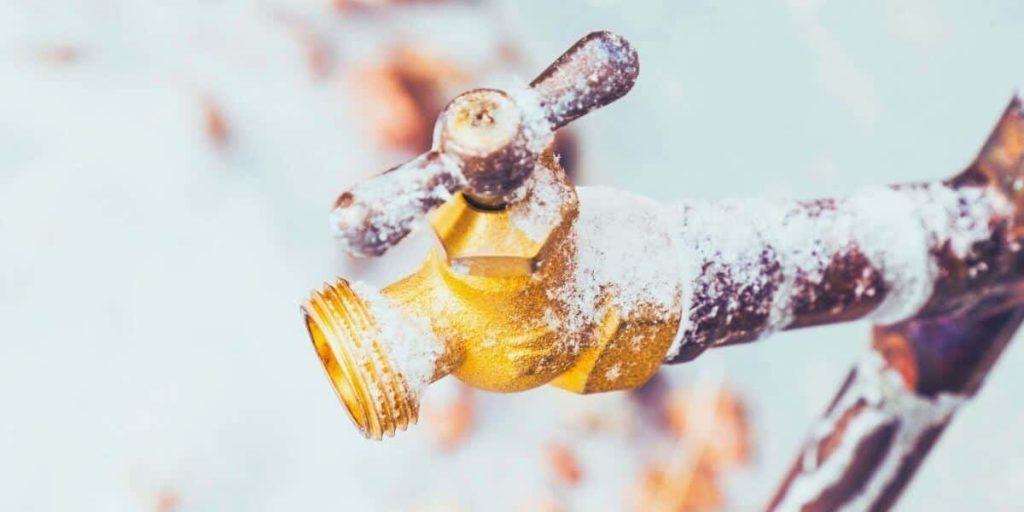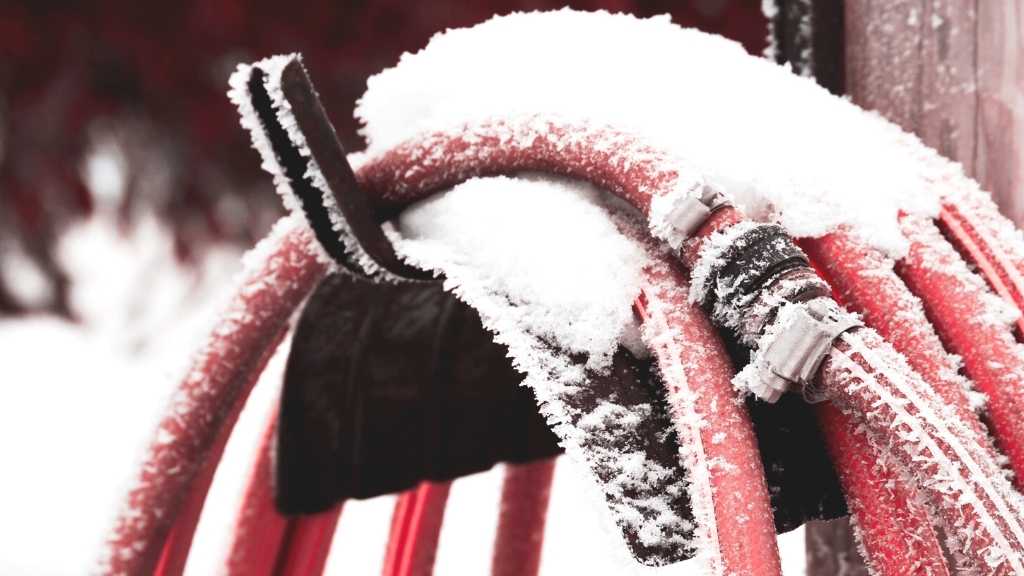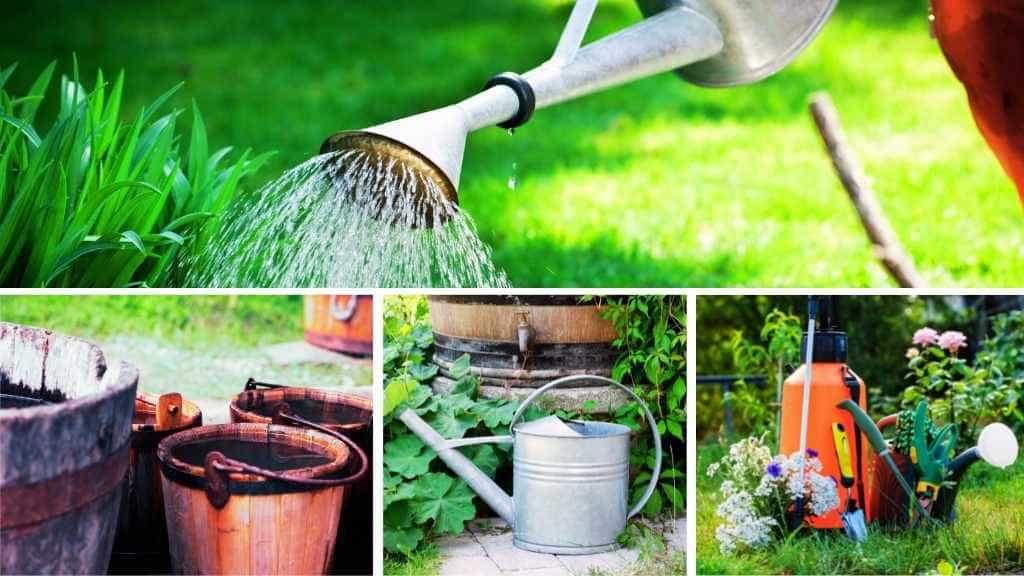One of the first concerns we had while winter was knocking at the door, was to understand if a garden hose can suffer any damage due to low temperatures. After doing some research on the subject, we soon found out one of the first reasons that make garden hoses crack or, even worst, burst, is because they are not properly stored and winterized before the cold season starts. So, can garden hoses freeze?
In reality, it is not the garden hose that freezes, but the water inside it (or on top of it). A dry garden hose will not freeze for as long as it remains dry. If your garden hose is wet on the outside and/or it is still filled with water, it will start freezing when the water reaches its freezing temperature point (32°F / 0°Celsius), and below.
In this post, we will elaborate more on this topic and provide more details on what happens if your garden hose freezes, what are the best actions you can take to avoid it, and what other parts of the watering system you might consider protecting during the cold season. Therefore, make sure you keep reading!
Can I leave my garden hoses outside during winter?
Hoses can be safely stored outside during the cold season if they are not yet attached to the faucet and if water is drained before the freezing temperatures hit. Additionally, it is recommended that you roll the water hose in a loop and store it vertically, on a holder or fence, to prevent it from being covered in melted snow, for example. The water resulting from the melted snow will freeze, and so the hose will freeze as well.
Another thing to consider is the temperature oscillation which might cause damage to the hose depending on the quality of the material that the hose is made of. To enjoy your garden hose for more years, you might consider storing it in a cool and dry place during the winter season.
Whenever we hear that freezing temperatures are to be expected, at the beginning of the cold season, the first thing we do is to disconnect the water hoses from the outdoor spigots. We choose not to take any risks, but sometimes cold weather can still come suddenly.
Continue reading below for more details on how you can protect your outdoor water hose from freezing.
How do I keep my garden hose from freezing in the winter?
There are a few simple steps we usually take to prepare our garden hoses for the cold season. It might be helpful to follow these as described below:
- Make sure the outdoor faucet is turned off and disconnect the water hose from the faucet
- Disconnect any fitting, handle, sprayer, or other accessories that you might have installed at the other end of your water hose
- Straighten the hose and pay attention to any kinks that might prevent the water from draining
- Check the entire length of the garden hose, lifting every meter as you walk along it, to make sure all the water is draining out
- Wrap the hose into a loop and place it in a vertical position. Both ends of the hose should be facing the ground. You can place it on a hose holder, on a fence, or on a hook
- Wait until all the water inside the hose has drained.
- Once you are sure the hose is dry you can store it either outside or inside.
If you choose to leave your garden hose outdoors during winter, make sure it is stored in a vertical position, away from direct sunlight.
The best option is to store it indoors, no matter if it is a cold, unheated space like a basement or garage, storing it in a dry place, will increase its lifespan for sure.
What happens if your garden hose freezes?
So, let’s say you forget to protect your garden hose for the cold season and winter comes unexpectedly. What will happen in this case? To answer that we must ask ourselves a more common question, such as what happens when water freezes?
When chilled or brought to freezing point, water reacts differently than other liquids in the sense that where most liquids will shrink while water will expand its volume.
Considering the above, if your garden hose is still carrying water inside in the cold season, that water will expand during the freezing process and this might cause different levels of damage to the hose, depending on the hose material type. In terms of damages, you can expect anything starting from hose shape damage, to cracks and holes, or even hose bursting in some cases.
Things might get even worst if your water hose is attached to an outdoor spigot because it will then cause the water in the pipe to freeze, and pipes are more exposed to bursting. Also, pipe joints can quickly break because of this. The lifespan of your garden hose will decrease if the water hose freezes.
As a precaution, all plumbing specialists recommend detaching the water hose from the outdoor spigot before the first frost in the season.
Can a running water hose freeze?
There are increased chances for this to happen but there is no precise way to determine the precise time and/or temperature level that it will take for a running water hose to freeze.
It is a fact that water will start freezing at 32 degrees Fahrenheit (0 degrees Celsius). But when the water is flowing, it is continuously mixing with the exterior frozen water particles, and this continuous movement and mixing slows down the freezing process. Basically, the faster water runs, the lower the temperature that will be required for it to freeze.
To conclude, we can’t precisely determine the freezing point of a running water hose as this depends on other significant factors, main ones are mentioned below:
- The material type of the garden hose
- The diameter of the hose
- The length of the hose
- The speed of the running water
Thicker material will require lower temperatures and more time for running water to freeze. A hose with a larger diameter will allow a higher volume of water to run through the hose and this will increase the time it takes and will require lower temperatures for the water to freeze. Regarding the length of the hose, a longer hose will cause running water to freeze faster due to the longer surface the water must cover until it exits the hose. And of course, regarding the speed, as mentioned before, the faster water runs, the longer it takes for it to freeze.
How do you fix a frozen garden hose?
To defrost a frozen garden hose is normally a simple process but it might take some time, hours in most cases.
The first step is to detach the hose from the outdoor spigot in case it is still hooked. Then manually check the hose to determine the parts that are frozen. Going further you have several options to defrost it, such as:
- Move it to a warmer location
- Use a hairdryer to thaw the frost
- Move it to a sunny spot even if the outside temperature is still very low. The water will start melting as the hose materials attract sun heat even during cold weather.
Then be patient, wait until the water melts, and dry it out of the hose as explained above in the section where we were talking about steps to take for protecting the water hose from freezing during the cold season.
In case you need to unfreeze a hose from a faucet handle, most options involve adding a heat source to the hose bib. You can easily solve this by wrapping the hose bib in a clothing material or towel and pouring hot water on it, repeat the process until all the ice has melted and the hose can be safely removed from the hose bib.
At what temperature do hose bibs freeze?

Hose bibs, otherwise known as outdoor faucets or garden hose spigots, are very vulnerable during the cold season and susceptible to freezing. We can’t know for sure at what temperature the hose bibs will freeze but the risks are very high starting with 20 degrees Fahrenheit and below.
How do you protect outside faucets from freezing?
There are a few simple but critical steps to take to winterize your hose bibs before the cold season. Specialists recommend taking these steps even if you have anti-freeze hose bibs.
- Remove the garden hose from the outdoor hose bib
- Turn off the water supply for your hose bib
- Open the hose bib and wait until all remaining water drains out. Keep it open during the entire season
- Attach a hose bib winter protector or cover the hose bib with waterproof polyester material to protect it from freezing temperatures
- Repeat these steps for all the outdoor hose bibs
When the warm season starts, to start using your garden water hoses again, redo this process in the reversed order.
First, remove all the covers or protection caps from the spigot, close the outdoor hose bib, turn on the water supply for your hose bib and attach back the water hose to it.
Conclusions
It is a known fact that both garden hoses and outdoor hose bibs need special care before the freezing temperatures hit. Winterizing a garden hose is a very simple process that doesn’t take so much time to complete. However, doing this type of maintenance and preparation will save you a lot of money in the long run as, by taking the proper care of your garden hoses, you will be using them for more and more seasons, increasing their lifespan.
In this post, we explained in more detail the impact that the cold season can have on your watering tool, specifically garden hoses and outdoor hose bibs, how you can take the correct actions in advance and winterize these tools and how you can fix a garden hose in case it freezes.



